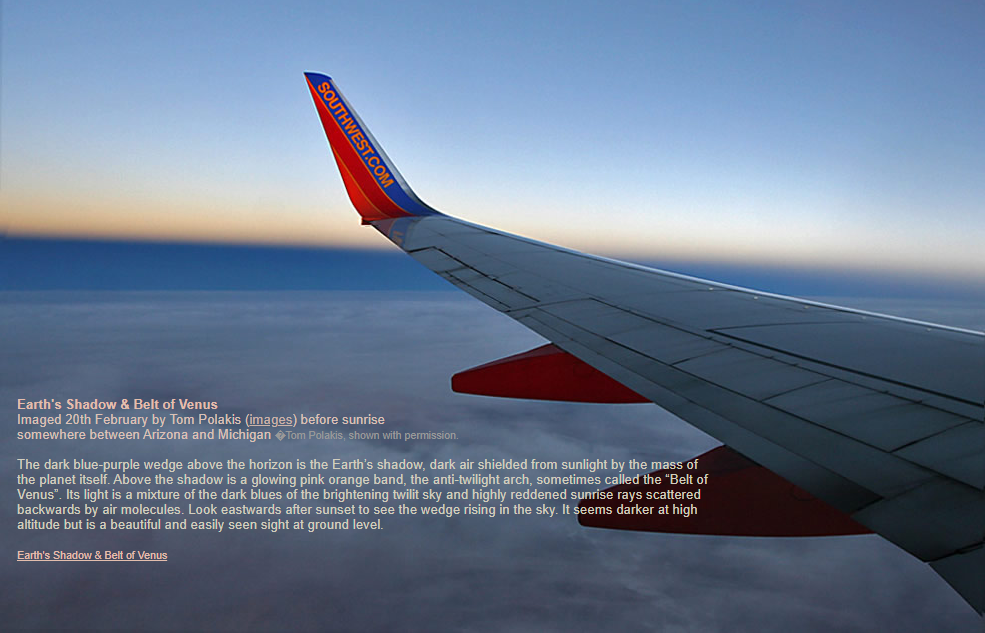Earth Shadow & BOV
Earth Shadow & Belt of Venus: A Captivating Atmospheric Phenomenon
Have you ever gazed at the sky during twilight and noticed a dark blue-purple wedge rising above the horizon? That intriguing sight is known as Earth's Shadow, a phenomenon where a portion of the atmosphere is shielded from direct sunlight by the mass of our planet itself. But that's not all - just above the shadow lies a breathtaking pink orange band called the Belt of Venus. In this article, we will explore these atmospheric marvels in detail and uncover the fascinating science behind them.
Earth's Shadow: A Shield of Darkness
As the sun sets below the horizon, the Earth casts a shadow into the atmosphere. This shadow appears as a wedge-shaped region of dark blue-purple hues rising above the eastern horizon after sunset or the western horizon before sunrise. The Earth's Shadow is created when sunlight is blocked by the curvature of our planet, preventing it from reaching the atmosphere directly. Instead, the shadow is formed by sunlight being scattered and refracted around the Earth's surface.
The Belt of Venus: A Radiant Glow
Directly above the Earth's Shadow lies the mesmerizing Belt of Venus. This glowing band showcases a mix of pink and orange hues, creating a stunning visual spectacle during twilight. The Belt of Venus is also referred to as the anti-twilight arch due to its appearance opposite to the direction of the setting or rising sun. Its enchanting colors are a result of a combination of factors, including the scattering of reddened sunrise rays and the dark blues of the twilit sky.
Understanding the Science Behind Earth's Shadow and the Belt of Venus
The Earth's Shadow and the Belt of Venus are captivating examples of atmospheric optics, where light interacts with various components of the atmosphere to create remarkable visual phenomena. To understand these phenomena better, let's delve into the science behind them:
-
Scattering: When sunlight passes through the Earth's atmosphere, it interacts with air molecules and tiny particles suspended in the air. This interaction causes the sunlight to scatter in different directions, leading to the dispersion of colors and the creation of captivating hues.
-
Rayleigh Scattering: The Earth's Shadow appears blue-purple due to a phenomenon called Rayleigh scattering. This type of scattering occurs when sunlight interacts with gas molecules in the atmosphere, particularly nitrogen and oxygen. The shorter blue and violet wavelengths of light are scattered more easily than longer wavelengths, resulting in the characteristic color of the Earth's Shadow.
-
Backscattering: The Belt of Venus owes its vibrant pink and orange colors to a process known as backscattering. As sunrise rays pass through the atmosphere, they encounter air molecules that scatter the light backwards towards the observer. This backward scattering enhances the reddened hues, creating the stunning display of colors seen in the Belt of Venus.
Observing Earth's Shadow and the Belt of Venus
To witness the captivating beauty of Earth's Shadow and the Belt of Venus, it is best to look towards the eastern horizon after sunset or the western horizon before sunrise. Here are some tips for optimal viewing:
-
Choose a Clear Sky: Ensure that the sky is relatively clear, as clouds can obstruct the view of these phenomena.
-
Find an Unobstructed View: Seek a location with an unobstructed view of the horizon, free from tall buildings or mountains that may block your line of sight.
-
Timing is Key: Plan your observation around sunset or sunrise to catch these atmospheric marvels at their most prominent.
-
Ground Level Viewing: While the Earth's Shadow may appear darker at higher altitudes, it is most easily observed and appreciated from ground level.
Conclusion
The Earth's Shadow and the Belt of Venus are awe-inspiring atmospheric phenomena that grace our skies during twilight. These captivating displays of light and color are a result of the complex interplay between sunlight, atmospheric particles, and the curvature of our planet. Whether you're an avid sky-gazer or simply appreciative of nature's wonders, taking a moment to observe and appreciate these phenomena can truly be a breathtaking experience. So, the next time you find yourself under the twilight sky, remember to cast your gaze towards the horizon and witness the enchanting beauty of Earth's Shadow and the Belt of Venus.

Earth's Shadow & Belt of Venus
Imaged 20th February by Tom Polakis (images) before sunrise
somewhere between Arizona and Michigan �Tom Polakis, shown with permission.
The dark blue-purple wedge above the horizon is the Earth’s shadow, dark air shielded from sunlight by the mass of the planet itself. Above the shadow is a glowing pink orange band, the anti-twilight arch, sometimes called the “Belt of Venus”. Its light is a mixture of the dark blues of the brightening twilit sky and highly reddened sunrise rays scattered backwards by air molecules. Look eastwards after sunset to see the wedge rising in the sky. It seems darker at high altitude but is a beautiful and easily seen sight at ground level.
Earth's Shadow & Belt of Venus
Note: this article has been automatically converted from the old site and may not appear as intended. You can find the original article here.
Reference Atmospheric Optics
If you use any of the definitions, information, or data presented on Atmospheric Optics, please copy the link or reference below to properly credit us as the reference source. Thank you!
-
<a href="https://atoptics.co.uk/blog/earth-shadow-bov/">Earth Shadow & BOV</a>
-
"Earth Shadow & BOV". Atmospheric Optics. Accessed on April 20, 2024. https://atoptics.co.uk/blog/earth-shadow-bov/.
-
"Earth Shadow & BOV". Atmospheric Optics, https://atoptics.co.uk/blog/earth-shadow-bov/. Accessed 20 April, 2024
-
Earth Shadow & BOV. Atmospheric Optics. Retrieved from https://atoptics.co.uk/blog/earth-shadow-bov/.